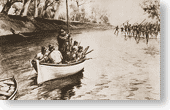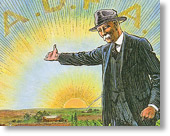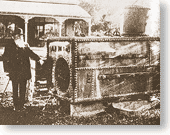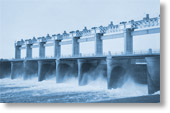
History of the Murray River

Forty million years ago, through the forces of water and geophysical uplifting, the valley that cradles Australia's greatest river began to take shape. The Murray is a river whose character encompasses environmental beauty, rich heritage and history, busy townships and major regional centres, with amazing tourism experiences and a world class, agriculture, food and wine regions.
It creates a natural border between New South Wales and Victoria and is the world's 16th-longest river at 2,520 kilometres. It is fed by several rivers including the Darling and Murrumbidgee on it's journey from the Australian Alps before flowing through South Australia to the Southern Ocean. It sits in the Murray-Darling Basin, draining most of inland Victoria, New South Wales, and southern Queensland from the western side of the Great Australian Divide (map (5 sections) or simple)
From millennia Aboriginal people have relied on the river’s abundance. The many various groups included Ingalta, Moorundie, Goodwarra, Parrian-kaperre, Tongwillum, and Yoorlooarra. In the Riverland (SA), the Ngarrindjeri people lived on and along the lands around the Murray and the Coorong and are, today, South Australia’s largest Aboriginal community.
First discovered by European explorers Hamilton H. Hume and William H. Hovell in 1824. It wasn't until five years later, however, that Charles Sturt navigated down the Murrumbidgee to encounter the Murray and named it after Sir George Murray, when his exploration party encountered the Darling connection.
Paddle steamers were used to carry wool, wheat, and other goods up and down the river system including the Murray, Darling and Murrumbidgee Rivers. Since settlement of the river basin was so late, the introduction of the railroad came much sooner to the river towns and had a large impact on the steamers along the Murray. Irrigation was introduced in 1887 by Canadian George Chaffey around Mildura (Victoria) and Renmark (South Australia). This greatly accelerated settlement and exploitation of the river's water supply.
In 1918, a commission was formed to manage water supply and it also coordinated the construction of storages, locks and weirs to reduce the effects of drought and flood. Today, the water flow is still managed by these locks on the river from Yarrawonga in Victoria to Blanchetown (Lock 1) in South Australia. Millions of people rely on the Murray as a source of water for domestic and industrial use and it plays a significant part in Australia’s economy.
A large and range amount of species can be found living in the river basin, including emus, koalas, Western Grey kangaroos, Bearded Dragon lizards, red-rumped parrots, black swans, pelicans, and even dolphins (closer to the ocean). Also plentiful are fish such as the Murray Cod, Bream, Perch, and Redfin.
To experience the diversity of the Murray is truly amazing. It will touch your soul. Enjoy your Murray experience.
- See how the Murray River formed
- Aboriginal History
- Murray River Flag - one of Australia's oldest
- Murray River Historic Timeline
- Explorers, Bushrangers and Legends
- Mannum Historic Walks and Morgan Historic Walk
- Chaffey Trail in Mildura
- Murray River Paddle steamers and paddle boats
- Explore the River Boat Trail in South Australia
Some river towns history:
Tell your friends you found this at murrayriver.com.au!
Copyright Discover Murray 2026. This site or any portion of this site must not be reproduced, duplicated, copied, sold, resold, or otherwise exploited for any commercial purpose that is not expressly permitted by DISCOVER MURRAY.






 Lee Kernaghan Boys From The Bush The Concert
Lee Kernaghan Boys From The Bush The Concert Kevin Bloody Wilson Aussie Icon Tour with special guest Jenny Talia
Kevin Bloody Wilson Aussie Icon Tour with special guest Jenny Talia The Australian Beach Boys Show
The Australian Beach Boys Show Little By Little
Little By Little Amy Shark The Solo Acoustic "Songs & Stories" Tour
Amy Shark The Solo Acoustic "Songs & Stories" Tour




